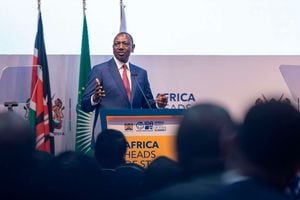Nairobi Gallery expo set to honour nine pioneer women artists’ bold brushworks

The work of nine pioneer women artists will be displayed at the Nairobi Gallery. PHOTO| WILLIAM RUTHI
What you need to know:
- Theresa Musoke, the Ugandan artist who lived, worked and exhibited in Kenya for 20 years when her country was in turmoil, also got her first university degree from Margaret Trowell’s Art Department at Makerere.
- But then she became one of the first African women to win a Commonwealth scholarship to study and exhibit at the Royal College of Art in UK.
Appreciation of women’s role in the development of the visual arts in East Africa has been a long time coming. But that oversight is being rectified as of next Sunday, September 9, when the Nairobi Gallery (the former provincial headquarters just next to Nyayo House) hosts a monumental exhibition featuring the artistic expressions of nine extraordinary “Women Pioneers in the Arts.”
Every one of the nine has an exceptional story to tell, starting with Margaret Trowell, the English artist who came to Uganda in the 1930s and launched the fine art department at Makerere University.
That department has produced countless creatives including several women among the notable nine. Among them is Kenya’s own Rosemary Karuga, now 92, who was the first Kenyan woman to attend Makerere’s fine art department from 1950 to 1952.
But her artistic career was cut short once she returned to Kenya during the Emergency, got married and went into teaching until the 1990s when, upon ‘retirement’ she began creating her inimitable collage art using local materials, including recycled paper packaging from local soaps and maize flour.
Her career quickly took off and in 2006 she became the first Kenyan woman to receive a Lifetime Achievement Award for creative contribution to society. Currently, she lives abroad with her daughter in the UK.
Theresa Musoke, the Ugandan artist who lived, worked and exhibited in Kenya for 20 years when her country was in turmoil, also got her first university degree from Margaret Trowell’s Art Department at Makerere. But then she became one of the first African women to win a Commonwealth scholarship to study and exhibit at the Royal College of Art in UK.
She went on to get a Masters in fine art from the University of Pennsylvania in the US, and later taught in Kenya at ISK, Kestrol Manor and Kenyatta University alongside another one of the nine women pioneer artists.

Geraldine Robarts. PHOTO| MARGARETTA WA GACHERU
Geraldine Robarts didn’t study at Makerere. But she taught fine art there as well as at Kenyatta University, where she trained everyone from Elkana Ong’esa to Gakunju Kaigwa. Yet just like Theresa, her primary passion is painting and she’s exhibited her oil paintings all over the world, from China and Europe to UK, US and Canada.
Prof Magdalene Odundo didn’t attend Makerere; but like all nine women pioneer artists, she’s an educator as well as an acclaimed ceramicist whose award-winning art is based on years of researching pottery techniques both from her own Western Kenyan traditions and from other parts of world.

Magdalene Odundo. PHOTO| FILE
Recently elevated to Chancellor of the University of the Creative Arts in Farmham, UK, Magdalene is the only Kenyan woman to be given an OBE from Queen Elizabeth in 2016.
UNIVERSITY-AFFILIATED
The remaining four are not academics in the sense of being university-affiliated. But they all have either mentored a myriad of emerging artists in the region or opened doors for them by other means.
For instance, the late Joy Adamson may be most renowned for her role in raising orphaned lions and writing books like ‘Born Free,’ which was made into movies and TV series that have inspired countless tourists to come here on safari. But she was also an accomplished artist and the first one to paint portraits of Kenya’s indigenous people back in the 1940s.
She also drew fauna and flora, many of which are on display at Nairobi National Museum. But it is her portraits that are the most enduring as invaluable records of Kenyan indigenous cultures, many of which are no more.

Joy Adamson. PHOTO| FILE
Two of the nine are co-founders of Kenya’s first commercial art gallery in Nairobi and the first to exhibit African artists like Ancent Soi and Jak Katarikawe.
The late Robin Anderson and Yony Waite established Gallery Watatu in 1968 together with British designer David Hart. Both brilliant artists in their own right, Robin was best known for her batik art on silk while Yony has preferred painting in oils on canvas.
She is best known for her paintings of the Athi Plains, but she also founded the Wildebeeste Workshops, one in Lamu where she’s worked with local women groups to create collaborative tapestries; the other is at Athi River where she also conducts artists workshops periodically.
Number nine is Nani Croze, another institution builder who established Kitengela Glass and Research Trust in 1979, founded the Kenyan Arts Diary in 2010 and also established the first Rudolf Steiner School in East Africa in 1969.
Self-taught as a painter, muralist and sculptor before she started creating glass art, Nani, like Yony, has run countless workshops, including some for young women from Nairobi slums.
Alan Donovan of the African Heritage House and director of the Murumbi Trust is the one who researched and curated this exceptional show which will be officially opened by the ministry of Education’s Cabinet Secretary, Ms Amina Mohamed.




